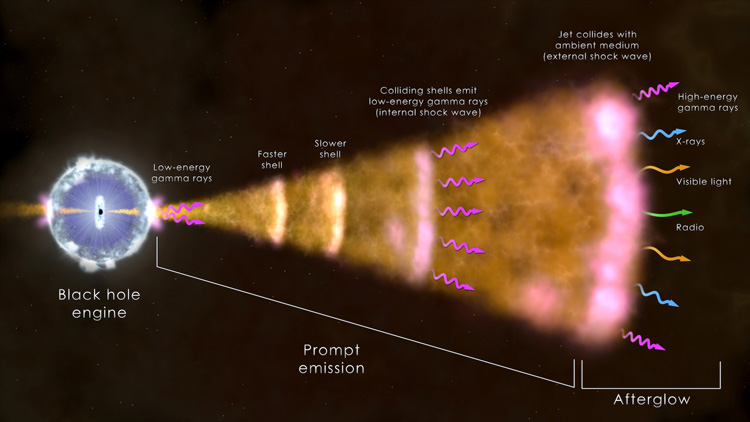News
Bright gamma ray burst confounds models of black hole birth
 Gamma ray bursts are thought to result when a massive star collapses to a black hole (left), sending jets of high-speed material outward along its poles. As the material slams into dust and gas around the star, radiation is emitted across the spectrum by hot ionized gas (plasma) in the vicinity of the newborn black hole, collisions among shells of fast-moving gas within the jet (internal shock waves) and from the leading edge of the jet as it sweeps up and interacts with its surroundings (external shock). The afterglow can be visible for months or years. Telescopes on Earth and in space detected many of these different wavelengths of light from GRB 221009A, enabling a detailed analysis of the event. (Graphic credit: NASA Goddard Space Flight Center)
Gamma ray bursts are thought to result when a massive star collapses to a black hole (left), sending jets of high-speed material outward along its poles. As the material slams into dust and gas around the star, radiation is emitted across the spectrum by hot ionized gas (plasma) in the vicinity of the newborn black hole, collisions among shells of fast-moving gas within the jet (internal shock waves) and from the leading edge of the jet as it sweeps up and interacts with its surroundings (external shock). The afterglow can be visible for months or years. Telescopes on Earth and in space detected many of these different wavelengths of light from GRB 221009A, enabling a detailed analysis of the event. (Graphic credit: NASA Goddard Space Flight Center) Last October, following one of the brightest flashes of gamma rays ever observed in the sky, telescopes around the world captured a wealth of data from an event that is thought to herald the collapse of a massive star and the birth of a black hole.
Raffaella Margutti, associate professor of astronomy and of physics at the University of California, Berkeley, notes that the data demonstrated that our models of such events are woefully inadequate.
